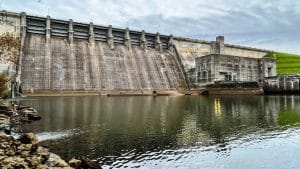September 30, 2022
By:
The U.S. Army Corps of Engineers Nashville District awarded a $91,250,000 contract today to American Bridge Company for the Center Hill Dam Spillway Gates Replacement Project.
Center Hill Dam is located on the Caney Fork River in Lancaster, Tennessee. The dam forms Center Hill Lake, which covers parts of DeKalb, Putman, White, and Warren Counties. It controls the runoff from a drainage area of 2,174 square miles.
Replacement is needed because a Spillway Radial Gate Evaluation Design Document Report in 2016 revealed the eight spillway tainter gates are subject to overstress due to trunnion friction issues. Trunnion friction is the force generated around the trunnion pin during a gate lifting operation. It is caused by the bearing of the trunnion pin against the gates’ trunnion hub and bushing, which is the rotating point of the gate. In addition, the gates and lifting equipment have been in operation since the dam was completed for full beneficial use in 1948.
The scope of this contract include fabrication of eight new spillway tainter gates; removal of existing gates and lifting machinery equipment required to operate the gates; and installation of the new gates and lifting machinery equipment.
Omar Acevedo, Nashville District project manager, said the contractor will systematically replace each gate. The contractor is limited to three inoperable gates at any period of time, always leaving five operable gates. As an additional risk reduction measure, only one gate bay will be open at any given time during construction. Replacement of gates will only occur between June and November each year, which is considered the dry season, targeting lower peak summer lake elevations.
This replacement project will ensure the authorized flood-risk-reduction capabilities of this project will be realized for many years to come. During construction, “the key takeaway is that public safety is our top priority,” Acevedo said. “Corps of Engineers’ water managers will maintain lake levels within current parameters agreed upon with the Southeastern Power Administration and the public will not experience significant drawdowns of the lake elevation. The most distinguishable change to reservoir levels during the construction period, may be a lower peak summer pool from 648 feet to closer to 645 feet. This adjustment would lower project risk during construction while still falling within current operating targets.”
Acevedo said it will initially take some time for the contractor to begin fabricating the new gates, so he doesn’t expect significant construction impacts in the near term to traffic crossing the dam on Highway 96. As the project proceeds later in 2023, the Corps of Engineers plans to communicate any road closures and impacts with signage, news releases, and posts on Center Hill Lake’s Facebook page at http://www.facebook.com/centerhilllake.
“The Corps of Engineers will do everything possible in the planning and execution phases of the project to reduce traffic impacts to local businesses and residents,” Acevedo added. “Traffic on Highway 96 will be reduced to one lane for the duration of the construction and occasional full closure up to 24 hours, but not on weekends.”
The contractor will also have to modify the bridge substructure for accessibility to accommodate replacement of the eight spillway tainter gates, which are 37-feet high and 50-feet wide, and to access lifting machinery equipment. This includes wire rope and drum setup, and replacement of high and low-speed gear boxes, 10 horsepower electric motor, bull and pinion gears, and the machinery base on each gate pier.
American Bridge Company, part of the Southland Holdings LLC group of companies, specializes in construction of new bridges, bridge rehabilitation and maintenance, complex structures, and marine construction. Its headquarters is located in Coraopolis, Pennsylvania.
The replacement of the spillway tainter gates and lifting machinery equipment will not affect the operation of the dam’s three hydroelectric generating units, which provide a total capability of 135,000 kilowatt-hours of hydropower.




